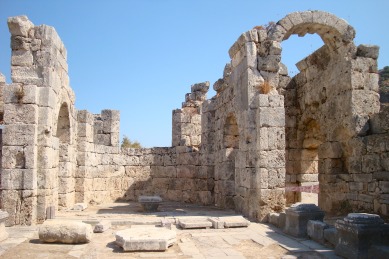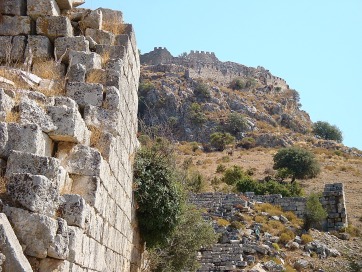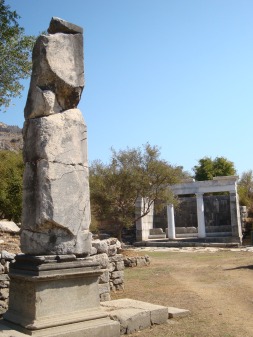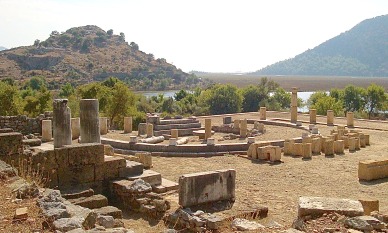The romantic ruins of Kaunos, an ancient settlement dating back to the ninth century BC, can be found on the western bank of the Dalyan river although from the far side the only visible remains are of the picturesque royal tombs cut into the rock.
To find the main site you need to walk about one km along the riverbank with fields of pomegranates stretching out towards the mountains on your right. There’s not much shade so bring a hat. Locals sell (overpriced) drinks along the way.
A lot of work was done at Kaunos in the 2000s and there is a lot to see at the site, most of it well-labelled.
Backstory
A Carian settlement, Kaunos reached its peak in the sixth and fifth centuries B.C. before falling under the sway of the Persians, the Ptolemies and finally the Romans. Although the city appears to have prospered from a trade in salt and slaves, its inhabitants were sickly folk, plagued by the mosquitoes that still torment summer visitors to Dalyan today (fortunately they no longer carry malaria).
At the height of Kaunos’ importance the sea would have come right up to its walls, but then it was slowly pushed back by silt deposited by the Dalyan River. What is now Sülüklü Gölü (Leech Lake) covers the probable site of one of the city’s harbours.
Little is known about when and why Kaunos finally collapsed.
 Around the site
Around the site
The main site at Kaunos is a flat raised area called the Palaestra-Terrace. This is dominated by the remains of a small domed 6th-century church with three aisles and a couple of chapels that were added later. A fine mosaic pavement is preserved beside it.
Up here too are the remains of a circular building that appears to have been used to calculate distances, as well as a huge Roman bathhouse.
Beyond the church stands the well-preserved horseshoe-shaped theatre that was designed to seat 5,000 people and offer them a fine view out towards the sea. Dating back to the Hellenistic period, it was extensively modernised under the Romans.
On the hill above it the remains of a castle restored in medieval times loom over the site from the acropolis.
Behind the theatre a path winds down towards the sea with one path heading off towards the acropolis with a magnificent view back over the river and the town.
The main path winds down to the lowest level of the town and emerges behind a fountain that resembles a small temple and was restored in 2005. It dates back to the reign of the Emperor Hadrian (r.117-38) and has on its west wall a list of Customs regulations.
The Harbour Agora, a piece of flat land just behind the harbour, is littered with ruined walls and monuments, amongst them the remains of a fine monument to Quintus Vedius, a priest who paid for the building of the gymnasium. To the north there was once a Temple of Apollo and along the back of the Agora ran a Stoa of which only traces remain today.
 Behind the Harbour Agora a stepped street climbs to a terrace on which was built the Temple of Zeus Soteros as well as a colonnaded circular structure that has been identified as a Heroon although it is believed to stand on the site of a much earlier shrine.
Behind the Harbour Agora a stepped street climbs to a terrace on which was built the Temple of Zeus Soteros as well as a colonnaded circular structure that has been identified as a Heroon although it is believed to stand on the site of a much earlier shrine.
A curious stone here, called the Baitilyos, came to be seen as a representation of Basileus Kaunos, the god-king of the city who appeared on many of its coins.
Most of the finds from the site are now in Fethiye Museum.
Transport info
You can easily reach the ruins of Kaunos by excursion boat from the quayside in Dalyan or Köyceğiz.
Alternatively, you can have yourself rowed across the Dalyan Çayı (Dalyan River), and then stroll along the riverbank until you reach the site, a better idea as it means you can control how much time you have to explore the ruins.
The road from Köyceğiz to Ekincik passes the turn-off to Kaunos which is very close to the mudbaths at Sultaniye.

